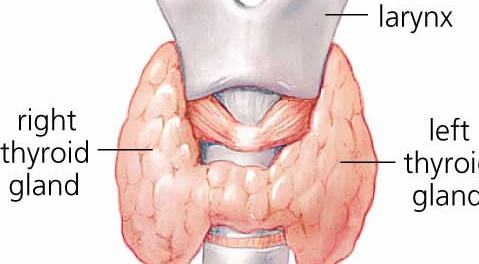
Thyroid gland: Hormones and functions
- Thyroid gland is located in neck, anterior to trachea. It consists of two lobe-one on each side of junction between laryngotrachea. The lobes are connected by a thyroid tissue called Isthmus.
- The gland is composed of two types of cells; follicular cell (secrete thyroid hormone) and para-follicular cell (secrete and store calcitonin hormone).
- Thyroid glands consists of hundreds of thousands of thyroid follicules which stores thyroid hormones.
- Follicles are made up of single layer of follicular cells.
Follicular cell:
- these cells are most prevalent cell.
- They secretes thyroid hormones (T3 and T4)
Parafollicular cell:
- cluster of parafollicular cells are found between follicluar cells.
- they are larger than follicular cell.
- parafollicular cells synthesize and secretes calcitonin.
*Thyroid is the only endocrine gland that is able to store its secretion outside the principle cells.
Location: in neck region on either side of trachea
Size: Each lobe is 4-6 cm long, and 1.5 cm thick
Hormones of Thyroid gland
1. Thyroxine (Tri-Iodothyronine and tetra-Iodothyronine)
- Follicular cells secretes thyroxine which contains 4 atoms of Iodine to form tetra-iodothyroxine (T4). Follicular cells also secretes tri-Iodothyroxine (T3) which contains only 3 atoms of Iodine.
- T3 and T4 collectively known as Thyroid hormone.
Functions of thyroxine hormone:
- Increase basal metabolism rate by increasing O2 comsumption in most tissues except lungs, brain, testis and retina
- Essential for growth of skeletal in children. Thyroxine is regulated by TSH from Pituitary gland.
- Increase carbohydrate metabolism, promote gluconeogenesis
- Effect on lipid metabolism
- Stimulate NA-K ATPase.
- Influence water and electrolyte balance.
- It is regulated by TSH
- At first T4 is synthesized which is converted to T3. T3 is five times more potent than T4.
- Deficiency of thyroxine: Goiter, Hypothyroidism
- Excess of thyroxine: thyrotoxicosis, hyperthyroidism.
2. Calcitonin
- Parafollicular cells secretes calcitonin. Calccitonin is a polypeptide hormone.
- Secretion of calcitonin is regulated by concentration of calcium in blood but not by feed back mechanism of Pituitary gland.
Functions of calcitonin:
- It lowers calcium level in blood ( antagonistic to parathyroid hormone)
- It acts directly on Osteoclast to reduce the remodelingof bone and increase reabsorption of calcium.
- It increases the movement of Ca++ from blood to bone.
Disorder of thyroid gland
1. Cretinism:
- deficiency of thyroxine in children
- pot belly, pigeon chest in children with physical and mental retardness
- dwarfism (cretins)
2. Myxedema:
- deficiency of thyroxine in adults
- puffiness of skin
- mental retardness
- low body temperature, BMR and blood pressure
3. Simple goitre:
- deficiency of iodine in diet and hence deficiency of thyroxine
- swelling of thyroid gland, visible in neck region
- low BMR. low Blood pressure and heart rate
- fatigue and sluggishness
4. Exopthalmic goitre (Grave’s disease):
- over stimulation thyroid gland
- goitre
- bulging of eye ball
- increased BMR, blood pressure and heart rate
- restlessness and nervousness

Sir can u plz tell the location where parafollicular cell is present.Is it present on the wall of thyroid follicle .And is its secretion calcitonin also present in colloid along with synthesized T3 and T4
Sir if T3 is much more active than T4 then why the level of T4 is more in blood than T3.Is it because it might work on the way before it reaches the target cell.And if its T3 that is more active does the T4 after reaching to target cell convert to T3?